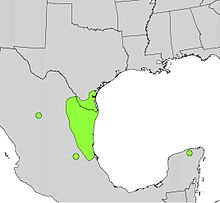Ebenopsis ebano
| Ebenopsis ebano | |
|---|---|

| |
| Fruit | |
| Scientific classification | |
| Kingdom: | Plantae |
| Clade: | Tracheophytes |
| Clade: | Angiosperms |
| Clade: | Eudicots |
| Clade: | Rosids |
| Order: | Fabales |
| Family: | Fabaceae |
| Subfamily: | Caesalpinioideae |
| Clade: | Mimosoid clade |
| Genus: | Ebenopsis |
| Species: | E. ebano
|
| Binomial name | |
| Ebenopsis ebano | |

| |
| Natural range | |
| Synonyms | |
|
Acacia flexicaulis Benth. | |
Ebenopsis ebano is a species of flowering plant in the family Fabaceae,[2] that is native to the coastal plain of southern Texas in the United States and eastern Mexico.[3] It is commonly known as Texas ebony or ebano (in Spanish).[2]
Description
[edit]Texas ebony is a small, evergreen tree that reaches a height of 7.6–9.1 m (25–30 ft) and a crown width of 1.8–4.6 m (5.9–15.1 ft).[4]

Habitat and range
[edit]The range of E. ebano stretches from Laredo and Corpus Christi, Texas[5] south through the states of Tamaulipas, Nuevo León, San Luis Potosí, Veracruz, Campeche, and Yucatán in Mexico.[6] It can be found in the Tamaulipan matorral,[7] Tamaulipan mezquital,[8] Veracruz dry forests, and Yucatán dry forests ecoregions.[9] Its habitat extends from sea level to 1,000 m (3,300 ft), averages 20 to 27 °C (68 to 81 °F) in temperature, and receives a mean of 900 mm (35 in) of annual rainfall.[6]
Uses
[edit]Texas ebony is cultivated in xeriscaping for its dense foliage and fragrant flowers.[10] It is also used in bonsai.[11]
Ecology
[edit]Ebenopsis ebano is a host plant for the caterpillars of the coyote cloudywing (Achalarus toxeus)[12] and Sphingicampa blanchardi.[13] The seedpods host the bean weevils Stator beali and S. limbatus. Despite the native range of Texas ebony overlapping with that of the latter, S. limbatus only feeds upon it in locales where it is grown as an ornamental and is not native.[14] E. ebano is also a preferred host of the epiphyte Bailey's ball moss (Tillandsia baileyi).[15]
References
[edit]- ^ Contu, S. (2012). "Ebenopsis ebano". IUCN Red List of Threatened Species. 2012: e.T19891615A20070381. Retrieved 14 March 2023.
- ^ a b c "Ebenopsis ebano". Germplasm Resources Information Network. Agricultural Research Service, United States Department of Agriculture. Retrieved 2009-11-25.
- ^ "Ebenopsis ebano (Texas Ebony)". Native Plant Database. Lady Bird Johnson Wildflower Center. Retrieved 2009-07-06.
- ^ Irish, Mary (2008). Trees and Shrubs for the Southwest: Woody Plants for Arid Gardens. Timber Press. pp. 178–179. ISBN 978-0-88192-905-8.
- ^ "Ebenopsis ebano (Berl.) Barneby & Grimes Texas ebony". The PLANTS Database. United States Department of Agriculture. Archived from the original on 2010-10-19. Retrieved 2010-11-25.
- ^ a b "Ebenopsis ebano (Berl.) Britton et Rose" (PDF). Reforestación: Fichas Técnicas (in Spanish). CONAFOR. Retrieved 2009-07-09.
- ^ García Pérez, Jaime F.; Óscar Aguirre Calderón; Eduardo Estrada Castillón; Joel Flores Rivas; Javier Jiménez Pérez; Enrique Jurado Ybarra (2007). "Germinación y establecimiento de plantas nativas del matorral tamaulipeco y una especie introducida en un gradiente de elevación". Madera y Bosques (in Spanish). 13 (1): 99–117. doi:10.21829/myb.2007.1311238.
- ^ Lentz, David Lewis (2000). Imperfect Balance: Landscape Transformations in the Precolumbian Americas. Columbia University Press. p. 79. ISBN 978-0-231-11157-7.
- ^ Beletsky, Les (2006). Southern Mexico: the Cancún Region, Yucatán Peninsula, Oaxaca, Chiapas, and Tabasco. Interlink Books. p. 23. ISBN 978-1-56656-640-7.
- ^ Miller, George Oxford (2007-03-15). Landscaping with Native Plants of the Southwest. MBI Publishing Company. p. 63. ISBN 978-0-7603-2968-9.
- ^ Mahler, Robert; Julian Velasco (2008). Pat Lucke Morris; Sigrun Wolff Saphire (eds.). Growing Bonsai Indoors. Brooklyn Botanic Garden. pp. 48–49. ISBN 978-1-889538-42-6.
- ^ "Coyote Cloudywing Achalarus toxeus (Plötz, 1882)". Butterflies and Moths of North America. Retrieved 2010-03-30.
- ^ "Sphingicampa blanchardi". Butterflies and Moths of North America. Retrieved November 16, 2018.
- ^ Fox, Charles W. (2006). "Colonization of a new host by a seed-feeding beetle: Genetic variation, maternal experience, and the effect of an alternate host" (PDF). Annales Zoologici Fennici. 43: 239–247.
- ^ Sill, Sue (May 2009). "Tillandsia baileyi rose - Texas's Disappearing Native Air-Plant" (PDF). The Sabal. 26 (5). Native Plant Project: 1–5.
External links
[edit]- "Texas Ebony, Ebano, Ebony Blackbeard, Ebony Apes-earring Pithecellobium flexicaule". Benny Simpson's Native Trees of Texas. Texas A&M University.
- "Pithecellobium flexicaule" (PDF). Digital Representations of Tree Species Range Maps from "Atlas of United States Trees" by Elbert L. Little, Jr. (and other publications). United States Geological Survey.
 Media related to Ebenopsis ebano at Wikimedia Commons
Media related to Ebenopsis ebano at Wikimedia Commons Data related to Ebenopsis ebano at Wikispecies
Data related to Ebenopsis ebano at Wikispecies

